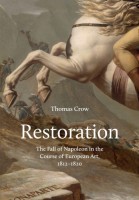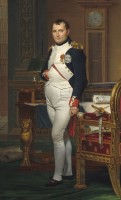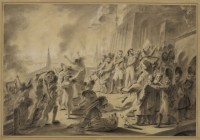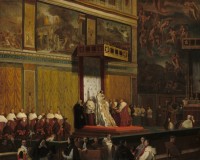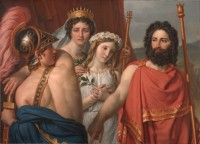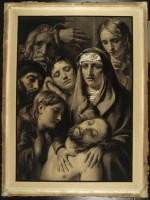The browser will either open the file, download it, or display a dialog.
Thomas Crow,
Restoration: The Fall of Napoleon in the Course of European Art, 1812–1820.
Princeton: Princeton University Press, 2018.
208 pp.; 12 b&w and 160 color illus.; index.
$39.95 (hardcover)
ISBN: 9780691181646
Restoration: The Fall of Napoleon in the Course of European Art, 1812–1820 is the published version of Thomas Crow’s 2015 A.W. Mellon Lectures at the National Gallery in Washington, DC. To be invited to give the Mellon Lectures is to be recognized as an unofficial laureate for the discipline of art history, the American equivalent of a Slade Professorship. The prestige and attention accorded to the Mellon Lectures make them a bellwether of sorts, signaling broader disciplinary interests even as they recognize the contributions of a particular scholar. What is more, as a public program of the National Gallery’s Center for the Advanced Study of the Visual Arts (CASVA), the Mellon Lectures are also intended to make accessible current art historical scholarship to an audience of non-specialists.
In structure and content, the volume hews closely to the original six lectures, which remain accessible as video and audio files via the National Gallery’s website. Light revisions to the text add helpful details and clarity for readers. Restoration also has the benefit of footnotes, used with restraint to direct readers to important scholarly sources or, more rarely, to relevant primary documents. The rationale behind these additions to the published text are clear; less apparent is the reason for giving the book a title different from the one used for the lectures, “Restoration as Event and Idea: Art in Europe, 1814–1820.” Perhaps Princeton University Press saw greater marketing potential in a publication with “Napoleon” in its name and therefore jettisoned the more ambiguous original title? Yet it is precisely the problem of periodization, of discerning connections between political events and cultural ideas that the book engages most closely. Toward this end, Crow puts into play the idea of a “European Restoration” to signal his interest in an international or even transnational period of visual culture between 1814 and 1820.
What distinguishes “Restoration works of art” for Crow are signs of artistic innovation born of intense social and emotional uncertainty, even trauma. Chief among these signs is the fragment. Partial narratives, unfinished projects, proposals, half-starts: these “liberated fragments” constitute what Crow identifies as a discernable aesthetic response to Restoration. Also included within Crow’s concept of Restoration art are the thousands of objects stolen or displaced during the Napoleonic era. Whether and how to restore looted works to their previous owners were vexed questions with many international artists—including vocal detractors of Napoleon—advocating for the plunder to remain in the Louvre. With this expansive understanding of Restoration art, Crow amplifies heretofore muted conversations among artists like Antonio Canova, Jacques-Louis David, Thomas Lawrence, Théodore Géricault, and Francisco Goya. It is the latter’s aesthetically explosive yet politically impotent pair of paintings from 1814, The Second of May, 1808 and The Third of May, 1808, that Crow highlights as an “instance of Restoration works of art—even the greatest—launched but never arriving at their intended destination” (32).
As exemplary of Restoration aesthetics as Goya’s works may be—and Crow identifies not only the ambitious paintings of 1814 as illustrative of artist’s work in this vein but his Disasters of War print series, too—it will come as no surprise to those familiar with Crow’s past writings that it was the work of Jacques-Louis David (1748–1825) that prompted the author’s interest in the cultural implications of Napoleon’s decline and eventual defeat. Crow’s first book, the seminal Painters and Public Life in Eighteenth-Century France (1985), helped propel Anglo-American research into French art of the Revolutionary Era. There, David’s distinctive approach to neoclassicism played a key part; in Crow’s later Emulation: Making Artists for Revolutionary France (1997), it was David’s complex role as ambitious academician, attentive mentor, and radical painter-politician that took center stage. Restoration opens with the statement, “The origin of these studies, which examine the experiences of artists at the fall of the French Empire, began in curiosity about Jacques-Louis David’s final artistic phase in Brussels, his place of exile from 1816 as a proscribed revolutionary regicide” (1). To explore this final phase in David’s career, Crow applies a synthesis of the methods deployed in his two earlier books on French Revolutionary art. In Painters and Public Life, a socio-historical analysis of text and image revealed a radical or “oppositional” rhetorical mode in literature and painting; in Emulation, psychic drives and emotional attachments fuel a biographical approach to a history of David’s atelier.[1] Now, in Restoration, Crow seeks to identify a distinctive aesthetic response to the ideological conditions peculiar to post-Napoleonic society, and he structures his investigation as a series of intertwined biographies.
Plutarch’s Parallel Lives is cited early in Restoration. The first chapter opens with a discussion of a painting in the National Gallery’s collection, David’s Emperor Napoleon in His Study at the Tuileries (1812; fig. 1). Among the attributes David includes in the portrait is a bound volume with the gilded name Plutarque legible on its spine. Crow refers to the volume as “an edition of Plutarch’s exemplary ancient Lives,” without commenting further (5). There is no title visible on the spine, but its identity as the Parallel Lives is logical and long-standing. David’s careful inclusion of the black ribbon used to mark the place where the reader left off suggests that Napoleon is roughly mid-way through the book, between the Greek exemplar and his Roman counterpart. It is as if David is suggesting that comparison was not yet possible at this stage in Napoleon’s career. Crow, in fact, ascribes a good deal of ambivalence to David’s intent with this portrait, which seems designed to immortalize the confident general and sage First Consul of 1804 rather than the reckless Emperor of 1812. David’s reference to Plutarch is not the sole source of Crow’s interest in that signal text, which was as familiar to the military officers, politicians, diplomats, and artists of the European Restoration as any work of history or literature at the time.
Each of the six chapters of Restoration considers a pair or trio of artists whose responses to the collapse of the French Empire are juxtaposed in order to highlight the tensions and uncertainties constitutive of a post-Napoleonic visual mode. The first chapter springboards from a discussion of the 1812 portrait of Napoleon to a comparison of David’s pupils Antoine-Jean Gros (1771–1835) and Jean-Auguste-Dominique Ingres (1780–1867). Gros is best known for his heroic representations of Napoleon, whether leading his army, such as Napoleon on the Battlefield of Eylau (1808), or providing inspiration or succor, as in Napoleon Visiting the Plague-Stricken at Jaffa (1804). Moving beyond such famous paintings, Crow instead directs the reader’s attention to Gros’s drawing of Napoleon near the Kremlin as Moscow is set aflame by its inhabitants (fig. 2). Dozens of figures are arranged into discrete episodes that offer contrasting responses to the action: ecstatic Muscovites thrilling at the spectacle of the city’s self-immolation; heroic French officers aiding their injured comrades; desperate mothers gesticulating over the bodies of their murdered children; and alternately abject and defiant arsonists under arrest by French soldiers. Near the center stands Napoleon, whose expression hovers between disbelief and dejection while the gesture of one arm suggests calm resolve and the other instinctive fury. No painting of the subject was ever realized:
As the empire unraveled and shortly collapsed entirely, grand artistic projects could never come to realization. For a history of the art of the period, that means finding prime material in incomplete fragments: studies, sketches, and proposals. Gros’s Burning of Moscow demonstrates just how compelling and revealing such works can be, how much more immediate in their communication than the glaciated surfaces of a finished canvas (17).
As counterpoint to Gros’s Burning of Moscow, Crow presents Ingres’s Pope Pius VII in the Sistine Chapel (1814; fig. 3). Ingres executed the painting in Rome for a deeply Catholic French patron while Pius VII was still being held prisoner in the Palace of Fontainebleau by Napoleon. With its persuasive detail, this small but highly finished painting in the collection of the National Gallery appears to document the restoration of the imprisoned pope to his throne. Regally attired and surrounded by ecclesiastics and privileged visitors, the pope’s authority in the Sistine Chapel mirrors that of Napoleon in David’s famous Le Sacre de Napoléon (1806–07). Crow reads this as a deliberate pictorial riposte by Ingres toward his former teacher. “Where Gros’s work offered an honorific allusion to David, Ingres’s represented a reproach and rejoinder” (18). What qualifies Ingres’ painting as a work of Restoration art in Crow’s view is not its date but the fact that it represents an imaginary scene of a post-Napoleonic return to order. The painting, in fact, was finished the same week that the pope was released from detention in France. Here, then, was a work of art based on fragments—Ingres’s recollections and sketches of Pius VII, his memories and reproductions of Le Sacre—“reassembled in the effort to recover a coherent identity” (23).
Chapter 2 considers Francisco Goya (1746–1828) and Théodore Géricault (1791–1824) as they negotiate the vagaries of state patronage in Spain and France during and immediately after Napoleon’s imperium. Crow’s interest in the complex nature of Restoration art prompts discussions not only of the aesthetic intensity of Goya’s The Third of May, 1808 but also its dull reception. Conceived during the oppressive regime of Joseph Bonaparte, commissioned by the short-lived constitutional government that followed, and completed after the recall of the Spanish Bourbon king Ferdinand VII: the painting succumbed to the conditions of Restoration, “never arriving at its intended destination.” Crow explains of The Third of May, 1808 and its pendant, “Neither official approval nor disapproval of either painting was ever recorded; in fact, there is no record of their existence at all until they turned up in a Prado storeroom inventory in 1834” (32). Géricault, too, produced works that document the violence and uncertain loyalties that Crow characterizes as endemic to the era. The narrative ambiguity of his Charging Chasseur (1812) and Wounded Cuirassier (1814) are likewise matched by their political inscrutability. Yet, unlike Goya’s Restoration pendant pair, Gericault’s paintings were exhibited publicly and praised at the time. While the reception of Goya and Géricault’s Restoration works differed, Crow observes intriguing points of visual commonality. Among these was the tendency of both artists to displace intense emotion from human actors onto animals: “As the charge of meaning becomes too great for human subjects convincingly to convey, that load distributes itself over any other likely vehicles in the vicinity” (39).
Géricault again serves as half of an exemplary dyad in the following chapter, this time paired with the comparatively unknown French academician Antoine Jean-Baptiste Thomas (1791–1833). What connects the two is their overlapping residency in Rome from 1816: Thomas under the aegis of the French Academy and Géricault as an independent student. Despite their differences in circumstances and training, Géricault and Thomas responded similarly to the political and cultural stress of Restoration. Above all, their respective scenes of religious rituals and popular blood sports follow the “dark thread” that Crow observes running through Restoration art. Akin perhaps to Géricault’s tendency to displace unsettling emotional content onto animals was his and Thomas’s interest in graphic representations of bulls and horses being tormented for entertainment. The ritual of executing criminals in Rome on the eve of Carnival—part public entertainment, part warning against taking too far the liberties accorded by the pre-Lenten celebration—was also recorded by both artists. These mostly unblinking depictions (Géricault tended to omit some of the crueler details of riderless horse races), testify to “the responsibility for any artist aspiring toward greatness to confront the catastrophic levels of violence and endemic cruelty visited on Europe by the onset of total warfare” (91). For Crow, this responsibility is satisfied even if the novel butchery of total warfare is displaced onto comparatively routine displays of violence like bull fights and public executions.
With Chapter 4, Crow shows how the exigencies of Restoration reshaped the artistic careers of the Italian sculptor Antonio Canova (1757–1822) and the British painter Thomas Lawrence (1769–1830). Canova’s patronage by the extended Bonaparte family places him alongside David and Gros as a key artist of the Napoleonic era. Crow’s study takes up the artist during his Restoration career, when he found himself pressed into service by the Vatican to inspect, assess, and recover works of art looted by Napoleon from Rome. It was while in Paris fulfilling this mission that Canova met Lawrence. Lawrence, too, would be drawn into creating Restoration art through a quasi-official commission from Britain’s Prince Regent to produce portraits of all the major actors in the international struggle against Napoleon. The assignment took Lawrence to Rome, where he painted a portrait of the restored Pius VII. In this painting, Crow detects the tremors of religious uncertainty—a further consequence of Restoration that inflects devotional art of the period, particularly works by Ingres and the Nazarenes.
Crow devotes Chapter 5 to the art historical conundrum that gave rise to Restoration in the first place: the idiosyncratic late work of David, produced during his exile in Belgium. As already noted, Crow explains in the book’s introduction that it was his attempt to better understand the final phase of David’s career (“underestimated when not disparaged”) that led him to examine the historical processes that may have contributed to the distinctive appearance of these enigmatic works (1). What allowed Crow to see past the “awkwardness and incongruities” that have led some to dismiss David’s Belgian works as confused experiments by a depleted old man was their striking similarity to contemporary paintings and finished drawings by François-Joseph Navez (1787–1869). A devoted student of David, Navez returned to his natal city of Brussels when David emigrated there in 1816. So stark is the kinship between their works of 1816–17 that any suggestion that David was aesthetically adrift at this time is rendered doubtful (figs. 4, 5). Distinctive of both artists’ works in this moment is the close-up observation of figures and the suppression of most references to place or setting. Spatial compression and pictorial condensation are also marked. A consequence of this compositional pressure is a kind of collapse or splintering of narrative. Some figures may be recognizable as characters from classical myth or history due to certain attributes or gestures, but the cause of their strongly indicated emotions or their proximity to one another remains conjectural. Crow takes these distortions and departures from academic convention as evidence that David’s late style can be understood (along with contemporary works by Navez) as a deliberate answer to specific ideological conditions. And this conclusion leads Crow to detect in other works of art created between 1812 and 1820 a similar response to Restoration. “David was not the only artist reckoning with displacement and loss, nor were such undertakings a prerogative of advanced age.” Depictions of “outcasts and marooned survivors”—isolated figures brought together by terrifying circumstances—“acquired extra urgency” (151).
Crow’s chapter on David and Navez not only explains the impetus behind Restoration, but also points to a likely rationale for the book’s dyadic chapters. This structure allows Crow to insist on the relevance of specific historical actors while also diffusing to some extent the “great man” model that biographical studies risk promoting. By pairing or grouping artists in each of his chapters, Crow suggests that history is the key player in Restoration, not a singular genius. But historical forces are not alone decisive: like Plutarch, Crow endows his actors with varying qualities of agency. In other words, some artists, like some Roman emperors or Greek statesmen, respond more advantageously to their milieus than others. Recall Crow’s previously cited observation at the close of his chapter on Goya and Géricault regarding “the responsibility of any artist aspiring toward greatness to confront the catastrophic levels of violence and endemic cruelty” (91). Along with discussing exemplary artists who took up this responsibility, Crow condemns those who fail to confront ugly realities or expose injustice, even if obliquely. For instance, an 1814 painting by Louis-Philippe Crépin that attempts to allegorize the Restoration of Louis XVIII is condemned “as an example of truly servile art” (34). Like Plutarch, Crow understands the rhetorical value of a negative example.
Styles of Restoration art are explored in Chapter 6, where Crow counterposes Ingres and Géricault. What Crow descries in the enameled surfaces and seductive detail of Ingres’s paintings from around 1812 is a visual rhetoric of feudalism. Ingres’s themes, too, strike Crow as evocative of feudalism in their apparent nostalgia for chivalric actions, Catholic hegemony, and royal authority. Such seemingly disparate projects as Ingres’s Roger Freeing Angelica (1819), The Death of Leonardo (1818), and Christ Giving the Keys to St. Peter (1820) coalesce as a unified aesthetic when viewed in relation to Restoration. “What might appear as Ingres’s stylistic mobility or eclecticism acquires consistency as parallel affirmations of feudal order, each properly treated according to the decorum of its genre and occasion” (168). Ingres’s sympathy for “a quasi-mystical system of rank and power that united Bourbon and Habsburg dynasties” is not, in Crow’s telling, a cause for censure. Unlike the servile Crépin, Ingres developed a coherent aesthetic program in support of a personal ideological commitment not necessarily aligned with his own financial or professional interests. “The predictable ridicule that such works [as Roger Freeing Angelica] attracted from the critics in Paris, who jeered at Ingres’s ‘Gothicizing’ archaisms, could not deter him from his mission” (169). Again, it is the artistic confrontation with Restoration that Crow valorizes rather than any particular style. “For Géricault, once the proud wearer of the king’s [Louis XIII’s] uniform, feudal symbols represented a standing insult to humanity” (180). No work exemplifies Géricault’s rejection of the heraldic mode more emphatically than The Raft of the Medusa (1819). The painting’s refusal of feudal hierarchies and epic ironies is visible in virtually every aspect. Its ambiguous narrative commingles hope with loss, while discrete figural groupings retain a singular impact even as they coalesce into a convincing whole. Technique joins theme and composition in contributing to the work’s Restoration character. Crow explains that the artist’s recourse to bitumen as a means of darkening certain passages has muddied the scene and even caused damage to the surface of the work. “A great loss to be sure, but . . . [a] signal lesson that culminating and consummate work in this period need not announce itself as such: it can and most often does assume the appearance of the provisional or fragmentary” (184).
Crow’s parallel discussion of Ingres and Géricault facilitates useful comparison without pitting the artists against each other. And throughout Restoration, Crow largely avoids easy opposition in favor of allowing his readers to see different, but equally compelling visual responses to Restoration. This is not to say that the structural similarity between Restoration and Parallel Lives is entirely benign, however. With the classical model come likewise long-standing historiographic habits. For one, there is the tendency to cast historical networks as homosocial, not that Crow neglects women’s activities entirely. In his chapter on Géricault’s and Thomas’s overlapping period of study in Rome, he relies for his information about popular customs and spectacles almost entirely on Charlotte Anne Eaton’s account of her 1817–18 stay in the city, Rome in the Nineteenth Century (1820). Likewise, in Chapter 4, Crow discusses the important role played by Elizabeth Foster in facilitating Thomas Lawrence’s acquaintance with his future patron Cardinal Consalvi. In both instances, passages devoted to these interesting and influential British women add depth and texture to Crow’s account. Even so, their function within Crow’s narrative is kept to that of a go-between who facilitates or clarifies the connections among men. The emphasis on homosocial networks extends to the interpretation of works of art, with a salient example being the analysis of David’s engagement with the theme of Alexander, Apelles, and Campaspe. Here, the pivotal narrative as well as pictorial role played by Campaspe is elided, and the discussion focuses instead on David’s identification with Apelles, the ancient painter’s enervation before the nude Campaspe less a symptom of sexual longing than a sign of David’s own despondency in the waning months of Napoleon’s reign (42–49).
Crow’s ascription of a distinct phase of artistic production to the European Restoration is grounded in a particular understanding of history. To explain this in the first chapter of Restoration (as he did in the first of his Mellon Lectures), Crow advances a rhetorical gambit as innocuous to a general audience as it is potentially provocative to his scholarly peers:
For diagnostic purposes, not all periods in art history are created equal: works generated during exceptional moments of upheaval can reveal more about how art comes together from heterogeneous ingredients by dint of the exceptional exertions required to hold them together or, conversely, the failure of such efforts when the contradiction becomes too great to be contained inside any settled form (23).
Crow is surely correct in noting that different historical moments yield more or less opportunity for certain kinds of art historical engagement. Yet, Crow’s choice of phrase here draws attention to the discordancy between his apparent interest in expanding the study of Restoration visual culture and his reliance on a static (and contested) art historical canon. Granted, Restoration gives works by the rarely noted Thomas and Navez every bit as much relevance as examples by David, Goya, Gros, Géricault, and Canova. But this gesture is not a real challenge to the status quo. Despite the reach of Restoration ideology (which Crow tracks across Europe, noting its impact in North and West Africa, too), the main actors are French men. About mid-way through the book, Crow states:
The artists who have been figuring most prominently in this book add up to a roll call of the indisputable greats of the period: David, Goya, Canova, Gros, Géricault, Ingres. But Lawrence? . . . Even with some recent historical rehabilitation, few would place him in the company just listed (108).
His almost grudging admission of Regency Britain’s most sought-after portrait painter into the company of “the indisputable greats” signals certain contradictory aims in Restoration. On the one hand, Restoration points to the potential benefit of a more capacious understanding of Restoration visual culture; on the other hand, it turns on affirmations of canonical status. If Thomas Lawrence is already at the limits of serious art historical consideration, the terms of inquiry are pretty tightly circumscribed.
As a bellwether of current trends in nineteenth-century art history, Restoration signals the ascendance of comparativism as a methodology and of regional or global rather than national contexts for historical analysis. It also testifies to the persistence of a canon that is becoming increasingly difficult to justify. But Restoration does not shy away from its own ambivalences. Like the period it addresses, the book is no less compelling for its methodological tensions and uncertainties. Crow concludes his study with a soaring analysis of The Raft of the Medusa in which the competing ideologies of Restoration and republicanism commingle with those of nationalism and colonialism. These impulses seem momentarily to coalesce in Géricault’s study of the black sailor at the apex of the painting before dissolving again:
The universality so often claimed for the classical nude is in this modest canvas won by Géricault from the person of the survivor most marked and thereby relegated to insignificance in European eyes. His African model, known to artists by the single name of Joseph, had first made his name as an acrobatic performer, and it shows: in him were embodied the grace, agility, and toned harmonious musculature central to the beau ideal of masculine form. The African’s feat, as represented on the gargantuan [finished] canvas, was to have caught the attention of the ship, but the bare, unadorned silhouette of Géricault’s small study enlarges that triumph, making of it a victory over the invidious distinctions of rank that disfigure their bearers: the Restoration unrestored (187).
“Restoration unrestored” are the book’s final words, and they aptly summarize the artistic confrontation with post-Napoleonic Europe as presented by Crow. They resonate, too, with Crow’s sustained negotiation of the complex legacy of Jacques-Louis David. A consummately canonical artist whose reputation—during his lifetime and ever since—has nevertheless waivered in response to the attitudes and expectations of changing audiences. It is a question not of whether but when the Restoration canon will next be unrestored.
Elizabeth Mansfield
Professor, Art History
The Pennsylvania State University
ecm289[at]psu.edu
[1] Thomas E. Crow, Painters and Public Life in Eighteenth-Century France (New Haven: Yale University Press, 1985) and Thomas Crow, Emulation: David, Drouais, and Girodet in the Art of Revolutionary France (New Haven: Yale University Press, 1995).


